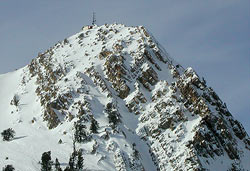
ソルトレークシティが今冬、2002 年冬季オリンピックおよびパラリンピック競技大会のために世界に向けて門戸を開くとき、悪天候は単なる懸念事項ではありません。悪天候によりスポーツ競技が遅れるだけでなく、道路や高速道路が雪や氷で覆われ、選手、オリンピック関係者、国際メディア、観客の会場へのアクセスが妨げられる可能性があります。
吹雪やその他の大規模な気象システムの影響は、ユタ州北部全体に広がっています。湖効果吹雪、氷霧、ギャップ ウィンド、斜面下降暴風、峠での視界不良などの危険な冬の天候は、多くの場合、地元の地形特性に関連しており、ワサッチ山脈やグレート ソルト レイクが最も顕著です。そのため、気象支援システムの計画は、国際オリンピック委員会が 2002 年のオリンピック開催地にソルト レイク シティを指定した直後の 1995 年に開始されました。
ソルトレイクシティ組織委員会 (SLOC) が管理するこのシステムには、Campbell Scientificの自動気象観測所が含まれており、大気科学コミュニティの公共、民間、学術部門の気象学者の協力を得ています。このシステムは、ワサッチ フロント (ユタ州の人口の大半が住むワサッチ山脈の西側の大都市圏で、標高約 1,300 メートルで 110 km にわたっています) に沿った屋内オリンピック会場と、男子ダウンヒル コースの頂上の標高 2,826 メートル (9,270 フィート) からクロスカントリー/バイアスロン コースの標高 1,670 メートル (5,480 フィート) までの範囲にあるワサッチ山脈の東側斜面の屋外会場のネットワークに広がっています。会場ごとに天気と気候は大きく異なります。
予報の責任も同様に多岐にわたります。オリンピックの気象サポートは、従来、開催国の主な気象機関が主導してきました。しかし、2002 年冬季オリンピックの気象予報業務は、国立気象局とソルトレイクシティの国立放送会社 (NBC) 系列局 KSL の予報官が分担します。NWS ソルトレイク気象予報局、NOAA 地域予報共同研究所 (CIRP)、NWS 西部地域科学サービス部門、ヒル空軍基地の航空保安運用センター (ASOC)、ユタ雪崩センターなど、他の機関の担当者が、オリンピック関連の特定のアプリケーションにデータ、リソース、予報を提供します。SLOC 気象サポート グループには、ユタ大学の学部生や大学院生、その他の地元住民などの気象ボランティアも含まれています。したがって、一貫した予報を確実に行うには、関係するすべてのグループの緊密な連携が不可欠です。
KSL チームは、5 つの屋外会場の詳細なミクロスケールの天気予報を提供する任務を負っている 13 人の民間気象予報士で構成されています。KSL の主任気象予報士であるマーク ユーバンクが編成した会場予報チームは、ユタ州北部の天気予報の豊富な経験を持っています。会場の予報士は、最新の気象観測、グラフ、モデル データに現場でアクセスできます。天気予報は 1 日 3 回発表され、必要に応じて更新されます。予報対象には、空の覆い、降水の種類と量、気温、風向、風速、突風、風の冷え込み、視程、湿度、積雪温度が含まれます。会場の予報士、NWS ソルトレイク フィールド オフィス、および ASOC の間で、毎朝合同の天気電話会議が行われます。公式の手動天気観測は、各屋外イベントの開始 1 時間前に開始され、イベント中は 15 分間隔で継続されます。
オリンピック前の気象状況の記録は計画に必要であり (また、オリンピック期間中は運営に必要であったため)、1996 年からユタ州北部の会場やその他の主要地点に気象観測装置が設置されました。1996 年のアトランタ夏季オリンピックで NWS 南部地域が配備した Campbell Scientific, Inc. 製のポータブル気象観測所は、夏季オリンピック終了後に NWS 西部地域で使用できるようになりました。また、1996 年には、NWS 西部地域と国立暴風雨研究所がソルトレイクシティ近郊で、複雑な地形の地域で WSR-88D レーダー アルゴリズムを検証する研究プロジェクトを開始しました。このプロジェクトをサポートするため、気象観測装置が 8 か所 (ワサッチ フロント内に 4 か所、オリンピック会場に 4 か所) に配備されました。
2002 年冬季オリンピックの準備として、予報と気象データの記録が進められ、1996 年以来、ユタ州北部および米国西部全域の気象情報を政府、民間、研究機関が共有するユニークなパートナーシップが発展してきました。当初はユタ メソネットと呼ばれていましたが、ユタ州外のデータ収集により、2000 年 1 月にメソウェストに名称が変更されました。現在、2002 年 2 月から 3 月にかけて、ユタ州北部地域の 278 か所以上の地点から気象観測が行われます。
この記事は、アメリカ気象学会紀要に提出された原稿から抜粋したものです。